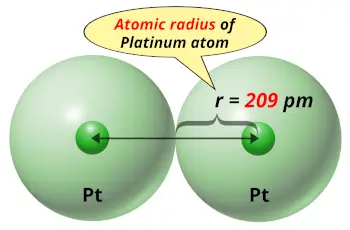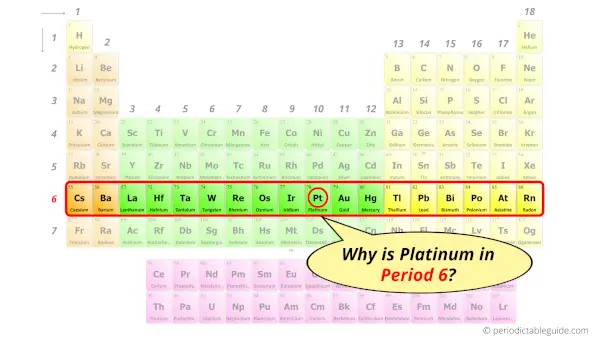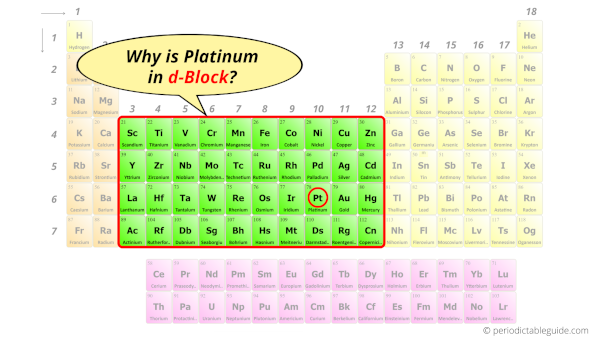
This is a SUPER easy guide on Platinum element.
In fact, the table mentioned below is the perfect information box (Which gives you every single detail about the Platinum element in Periodic table.)
So if you want to know anything about Platinum element, then this guide is for you.
Let’s dive right into it!
Platinum Element (Pt) Information
| Appearance |  Silvery white metallic |
| State (at STP) | Solid |
| Position in Periodic table |  Group: 10, Period: 6, Block: d |
| Category |  Transition metals |
| Atomic number or Protons | 78 |
| Neutrons | 117 |
| Electrons | 78 |
| Symbol | Pt |
| Atomic mass |  195.08 u |
| Electrons arrangement or Bohr model |  2, 8, 18, 32, 17, 1 |
| Electronic configuration | [Xe] 4f14 5d9 6s1 |
| Atomic radius |  209 picometers (van der Waals radius) |
| 1st Ionization energy | 9 eV |
| Electronegativity |  2.28 (Pauling scale) |
| Crystal structure |  FCC (Face centered cubic) |
| Melting point | 2041 K or 1768 °C or 3214 °F |
| Boiling point | 4098 K or 3825 °C or 6917 °F |
| Density | 21.45 g/cm3 |
| Main isotope | 195Pt |
| Who discovered Platinum and when? |  Antonio de Ulloa (in 1735) |
| CAS number | 7440-06-4 |
Platinum in Periodic table
Platinum element is in group 10 and period 6 of the Periodic table. Platinum is the d-block element and it belongs to transition metals group.
| H | He | ||||||||||||||||
| Li | Be | B | C | N | O | F | Ne | ||||||||||
| Na | Mg | Al | Si | P | S | Cl | Ar | ||||||||||
| K | Ca | Sc | Ti | V | Cr | Mn | Fe | Co | Ni | Cu | Zn | Ga | Ge | As | Se | Br | Kr |
| Rb | Sr | Y | Zr | Nb | Mo | Tc | Ru | Rh | Pd | Ag | Cd | In | Sn | Sb | Te | I | Xe |
| Cs | Ba | La* | Hf | Ta | W | Re | Os | Ir | Pt | Au | Hg | Tl | Pb | Bi | Po | At | Rn |
| Fr | Ra | Ac** | Rf | Db | Sg | Bh | Hs | Mt | Ds | Rg | Cn | Nh | Fl | Mc | Lv | Ts | Og |
| *Ce | Pr | Nd | Pm | Sm | Eu | Gd | Tb | Dy | Ho | Er | Tm | Yb | Lu | ||||
| **Th | Pa | U | Np | Pu | Am | Cm | Bk | Cf | Es | Fm | Md | No | Lr |
←Move to: Iridium (Ir) element – Periodic Table
→Move to: Gold (Au) element – Periodic Table
Why is Platinum in Period 6?

Let me ask you a question.
How many shells does platinum atom have?
It’s 6. Right?
You have already seen the bohr model of platinum atom in the above table.
From the Bohr model, it can be found that the number of orbits or shells in platinum is 6. Hence, as platinum has 6 orbits, it lies in period 6 of the Periodic table.
Why is Platinum in d-block?

Before knowing this reason, first of all I want to ask you a simple question.
How can you determine the blocks-wise position of elements?
The simple answer: The elements will lie in the s, p, d or f block will completely depend upon the subshell in which the last electron will enter.
For example; the electron configuration of platinum is [Xe] 4f14 5d9 6s1.
So the last electron of platinum enters the d-subshell or d-orbital.
Hence, platinum is the d-block element.
Is Platinum a Transition Metal? Why?

Yes, Platinum is a transition metal because it has incompletely filled d-orbital in its ground state.
Let me explain the exact meaning of this.
According to the definition of transition metals;
The element should compulsorily have incomplete d-orbitals, either in their ground state (M) or most common oxidation states (M1+, M2+, etc) then only they are called transition metals.
Now, the ground state of Platinum means its normal state in which it has neither gained nor lost any electron/s.
So the ground state of Platinum is Pt.
And the ground state electronic configuration of Platinum is [Xe] 4f14 5d9 6s1.
In this state, if we see the electron configuration of Platinum, then it possesses incomplete d-orbitals.

Because, there are only nine electrons in the d-orbitals (here 5d orbitals).
In order to have the complete d-orbitals, there must be 10 electrons in it.
But in the ground state electronic configuration of platinum, you can see that it has only 9 electrons in d-orbitals.
Thus, Platinum has incomplete d-orbitals.
And hence, as Platinum has incomplete d-orbitals, it is considered as a transition metal.
5 Interesting facts about Platinum
Interesting facts about platinum element are mentioned below.
- The name “Platinum” was derived from the Spanish word “platina”, which means “little silver”.
- Platinum is a very rare metal found from the earth’s crust. The concentration of platinum in the earth’s crust is around 5 parts per billion.
- South Africa is the leading producer of platinum in the entire world.
- More than 50% of the total platinum production is used in catalytic converters. And around 30% of platinum is used in jewelry.
- The quantity of platinum in meteors and moon rocks is more than the quantity of platinum available on the earth.
Properties of Platinum
The physical and chemical properties of platinum element are mentioned below.
Physical properties of Platinum
Physical properties of platinum are mentioned below.
- Platinum is a silvery white precious metal that has a lustrous surface. Hence platinum is also known as “white gold”.
- Platinum is a ductile as well as malleable metal.
- The melting point and boiling point of platinum are 1768 °C and 3825 °C respectively.
- The crystal structure of platinum is FCC (face centered cubic).
- There are many isotopes of platinum, but out of those isotopes, the most abundant isotope is 195Pt (which has an abundance of approximately 33.7%).
Chemical properties of Platinum
Chemical properties of platinum are mentioned below.
- Platinum is highly resistive to corrosion and it does not react with oxygen even at high temperatures.
- Platinum is chemically very less reactive, but it dissolves in hot aqua regia and forms chloroplatinic acid.
- The electronic configuration of platinum is [Xe] 4f14 5d9 6s1, which shows that it has incomplete d-orbitals. Because of this reason, platinum is classified as a transition metal on the periodic table.
Uses of Platinum
Uses of platinum are mentioned below.
- As platinum is highly resistive to corrosion and oxidation, it is used in jewelry.
- Platinum is a precious metal and hence it is used in currency as well as it is also used as an investment.
- The international standard kilogram weight was made of platinum iridium alloy. It contains 90% platinum and 10% iridium.
- Platinum is used in catalytic converters which converts the harmful emissions from the exhaust into less harmful gases.
Explore our New Interactive Periodic Table (with Rotating Bohr Models and More)

Details about this Periodic table:
- Access detailed info on all elements: atomic mass, electron configurations, charges, and more.
- View rotating Bohr models for all 118 elements.
- Get a free HD image of the Periodic Table.
Note: For future use, bookmark this Periodic table or visit “PeriodicTableGuide.com”
External resources:
- Platinum – Wikipedia. (2012, April 24). Platinum – Wikipedia. https://en.wikipedia.org/wiki/Platinum
- Platinum – Element information, properties and uses | Periodic Table. (n.d.). Platinum – Element Information, Properties and Uses | Periodic Table. https://www.rsc.org/periodic-table/element/78/platinum
- P. (n.d.). Platinum | Pt (Element) – PubChem. Platinum | Pt (Element) – PubChem. https://pubchem.ncbi.nlm.nih.gov/element/Platinum
- It’s Elemental – The Element Platinum. (n.d.). It’s Elemental – the Element Platinum. https://education.jlab.org/itselemental/ele078.html
- Platinum. (n.d.). Platinum. https://nature.berkeley.edu/classes/eps2/wisc/pt.html
